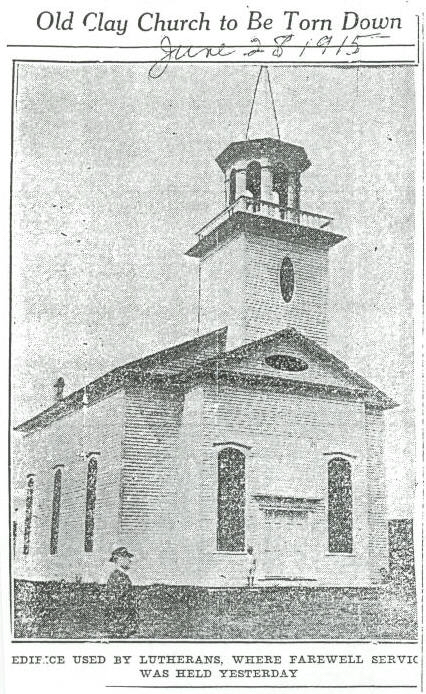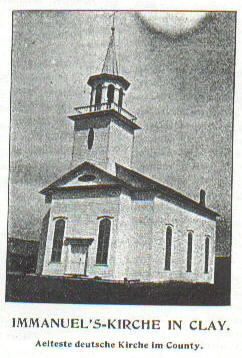A Timeline and Some Past Members:
1823 - 1828 - Rev. J. Senderling licensed to preach by the Hartwick Synod, sent to Clay to do missionary work. Stayed till 1828. Services held in schoolhouse.
1831 - 1837 - Rev. William Ottman sent to Clay as a missionary, had charge of the church till 1837, when he was sent to Wayne County as a missionary.
1833 - Dutch Settlement people built their church and dedicated it. "When the church was completed, they called a meeting and elected their church officers as follows: John Becker, Henry Becker Jr., and John Walters, as Trustees, and Richard Heller and Jacob Ottman, Elders. At this time the church was given the name of Immanuel Lutheran Church of the Town of Clay, Ononaga Co. and State of New York."
List of members up to 1836:
Jacob Ottman
Abraham I. Young
Jacob I. Young
John Becker
Henry Becker
Richard Hiller
Christina Ottman (Mrs. Jacob Ottman)
Christina Young
Isabel Young (Mrs. Jacob Young)
Christina Becker (Mrs. John Becker)
Miss Margaret Young
Miss Lydia Empie
Miss Caty Wise
Mrs. Henry Sommer
Mrs. Adam Becker
Mrs. Joseph Young
Miss Maria Canada
Mrs. John Ainsley
Mrs. Conne
Miss Mary Becker
Miss Eva Young
Miss Giddy Ann Walter
Miss Margaret VanDeWerken
Mrs. Richard Hiller
David Becker
Adam Becker
Andrew Becker
Lucy Kithum
Nicholas Sommer
John Empie
Mrs. Elizabeth Ketchum
Miss Mary I. Young
Miss Elizabeth Young
Miss Polly Kocher
Mrs. David Shafer
Mrs. David Shafer
Mr. Rulof VanDeWerken
Mrs. Margaret VanDeWerken
Mr. Stewart Scott
Mrs. Catherine Scott
Mr. Nicholas Sommer
Mr. Daniel Empie
Mr. Solomon Lemm
Mrs. Mary Sommers
Mrs. Merits
Miss Sally Cook
A little later in the records these names appear:
Adam Anthony 1843 - Confirmation
Miss Dorcas Van Hoesen - 1847 Baptism
Mrs. Henry Nash
Mrs. Catherine Nash - 1848
Mr. Peter Schell
Mr. Hiram Schell
Mrs. Elizabeth Schell
Miss Charlotte Young - 1853
Jacob Coughtry
Mrs. Catherine Coughtry
Mrs. Mary Weller - 1855
Later names among the church records include:
VanHoesen
Saddlemyer
Baily
Plaisted
Wagner
Wetsel
Gristwood
Fritcher
Rhodes
Davison
Shoemaker
VanVleck
Sotherden
Sitts
Barker
and others
1837-1838 - Rev. Benjamin Diefendorf called by the Lutheran Church of Clay and served there.
1839 - 1861 - Rev. William Ottman returned, preached for 22 years, retired for reasons of poor health in 1861.
1862 - Rev. Benjamin Diefendorf served as a supply preacher for one year.
1863 - 1866 - Rev. G. Hemperly called, preached at Clay and Cicero.
1866 / 1867 - Rev. Levi Schell accepted a call, stayed one year.
1867 - 1876 - Church had supply preachers from other churches, including Methodist and Dutch Reformed.
1872 - 1874? - Rev. Emmonds
1876 - Extensive repairs made to church, including new seats, pulpit, and newly built orchestra, new organ and carpet ($1,500 total). Jacob I. Young presented a bell to the church, still hanging in the belfry of the present-day church building in Clay.
1876 - 1878 - Rev. D. Lawrence accepts call to church; resigns.
1882 - 1886 - Rev. H. A. Strail was pastor, helped organize the Ladies’ Aid Society.
1887 - Rev. B. E. Fake
1890 - 1902? - Rev. G. Harsh
1896? - Rev. E. Jarvis? On 2 Dec. 1896 a marriage between William Van Epps and Matie Schell took place, with certificate signed by Rev. Edward Jarvis, pastor of 'Clay Lutheran Church' (but this pastor’s name was never in the church’s records).
1904 -1906 - Rev. Gilbert Strail
1906 - Congregation repaired the church. Tore out the orchestra, changed the doors, put in new seats, new stoves, new carpets and organ. Ladies’ Aid contributed $400, including $100 for repairing the sheds.
1907 - 1909 - Rev. Paul Ledin/Ledihen came as pastor, resigned in 1909.
1912 - 1914 - Rev. Ethelbert Davison, followed by Rev. Arthur Hardy (resigned Sept. 1914).
Sept., 1914 through 1915 (to 1916?) - Rev. Henry M. Schroeder serves as supply pastor from St. Peters Evangelical Lutheran Church, Syracuse.
1914 - Movement started to build a new church on its present site in the Village of Clay.
28 June 1915 - Farewell service held in the old church, attended by a large crowd.
19 Sept. 1915 - Cornerstone for new church laid.
4 June 1916 - New church building dedicated.
1916 - 1921 - Rev. J. C. Reichert called and served.
1922 - 1923 - Rev. J. W. Girard
1924 - 1927 - Rev. William Redcay, D.D.
1928 - 1931 - Rev. William Harding
1931 - 1978 - Rev. John W. Kisselburgh
July, 1979 - 1992 - Rev. Craig Herrick; went on to First English Lutheran Church, Syracuse.
1993 - 1994 - Rev. Doreen Brown, interim pastor
1994 - 1995 - Rev. K. Dorkof, interim pastor
1995 - 1997 - Rev. P. Hoh
1997 - 1999 - Vacancy Pastor - Rev. D. Whalen
1999 - present - Rev. Mark Wm. Allert
Article:
"Old Clay Church to be Torn Down"
1915
The following is a transcript of an unidentified Syracuse, N.Y. newspaper clipping, with penciled-in date of
June 28, 1915.

"Edifice used by Lutherans, where Farewell Service
was held yesterday"
Old Clay Church to Be Torn Down
MORE THAN 500 PERSONS ATTEND CHURCH AT CLAY
Farewell Service in Old Lutheran Edifice Draws Large Congregation
Speakers Tell of History
Rev. Carl Zinsmeister, Missionary, Superintendent of Synod,
Presides—
Many Other Clergymen on the Programme.
More than 500 persons, 536 to be exact, found sitting or standing room inside the doors of the little Lutheran church near Clay yesterday afternoon, when farewell services were held in the edifice, which is soon to be torn down and replaced by a large building a mile away in Clay village. When one considers that the seating capacity of the house is little more than 200 it will be understood that the ushers were busy persons while the congregation gathered.
Outside in the grass covered yard dozens of automobiles were parked, and in the cars were seated at least fifty persons who could not get into the church. A large number of these vehicles came from Syracuse, and many more from towns near Clay, bringing persons who wished to see for the last time one of the oldest churches in Onondaga county.
In the church things had been made festive for this last big service the building was to hold. Gardens for miles around had been shorn of their splendor in the way of roses to decorate it. There were potted plants from the homes of the church members, branches of evergreens, field daisies and wood fern everywhere.
Organ Buried in Bloosoms [sic].
The little organ was literally buried in masses of blooms, the two stoves, placed in opposite corners for heating the room in winter, were banked with greens studded with flowers; every window ledge was hidden, and the oil lamps, which have served so many years for lighting, were concealed beneath garlands of bright-hued flowers.
Many prominent Lutheran clergymen were seated with Rev. Carl Zinsmeister on the platform, and these all spoke a few words of praise for the good work done in the old building and wishes for the success of the new house of worship, the building of which is to begin next month. Rev. Mr. Zinsmeister, who is missionary superintendent of the synod of New York, was master of ceremonies.
Among the speakers were Rev. Henry M. Schroeder, pastor of St. Peters Evangelical Lutheran Church of this city and president of the western synod of New York. Rev. Mr. Schroeder has supplied the pulpit at Clay since the former pastor, Rev. Arthur Hardy, resigned last September and since when the chuhch [sic: church] has been without a pastor.
Other Clergymen Present.
Rev. Dr. H. G. Dattan, pastor of Zions Evangelical Lutheran Church of this city; Rev. Julius Paetznick, pastor of Mount Tabor Lutheran Church; Rev. John Wittekind, pastor of St. Johns Lutheran Church; Rev. Frederick Ellerman, pastor of St. Pauls Lutheran Church; Rev. F. V. Chryst, pastor of the Church of the Atonement; Rev. Mr. Davis of Clay; John M. Luther, president of the Lutheran Brotherhood of Syracuse, and A. E. Oberlander of this city were also among the speakers.
Musical numbers were given by the choir, by the men’s chorus of the Brotherhood, by William Kramer and Walter Wisehoon, the two latter giving solos.
A history of the church was Mr. Oberlander’s contribution to the programme. He told how, as far back as 1810, a little band of Lutherans settled at Clay and held services, although they had no church building then. A congregation was organized in 1825, and for these the present church was built. Beginning with a congregation of forty, the church membership now numbers more than 100.
None of the charter members are living, but among the olders ones still on the roll who attended the services yesterday was William A. Young, who has been a member seventy years.
Other Clergymen [sic: Members?] Present.
Others among the older members or former members present were Mrs. J. K. Harris, G. T. Young of Mexico, Dr. A. A. Young of Newark; Mrs. J. J. Young of Syracuse, Mr. and Mrs. P. W. Schell of North Syracuse, Mrs. William Miller of Syracuse, J. H. Carlysle, P. H. Heusen, Mr. and Mrs. O. C. Deman and Mr. and Mrs. Allen Gilmore of Clay.
After the service the old bell in the tower was rung, while the congregation sang, "God Be With You 'Till We Meet Again."
Three services were held in the church yesterday. Preparatory services were at 10 o’clock, followed by holy communion at 11 o’clock. The farewell service was preceded by a children’s service at which three infants received the sacrament of baptism.
There will be at least one more service in the old church before the work of demolition begins. Next Sunday Rev. Alfred H. Miller, who is one of the candidates for the pastorate, will come from New York to conduct services. After that services will be held in Weller Hall, Clay village, until the new church is ready to receive its people.
Building space has been given the church by Mrs. L. A. Weller and her children. The lot is located centrally in the village, which will give the new church advantages over the old, which is nearly a mile from the village center.
Building to Cost $3,000.
The Building Committee has under consideration a structure to cost $3,000. This amount is to be raised by subscription, or such part of it as may be necessary. The material in the old church will be used as far as possible in constructing the new.
The new house will have a capacity of 700. It will be built after the same plan as the one to be destroyed as far as architectural lines are concerned, but will be thirteen feet longer and there will be a basement for Sunday school purposes.
Links - for more information:
Immanuel Evangelical Lutheran Church, Clay, New York; current link:
http://www.immanuelclay.com/default.asp?sec_id=180019406
Rootsweb: HISTORY OF THE TOWN OF CLAY
Source: Past and Present of Syracuse and
Onondaga County, by The Rev. William M. Beauchamp.
NY: S. J. Clarke Publishing Co., 1908, pp. 353-356.
http://www.rootsweb.com/~nyononda/CLAY/BEAUHIST.HTM
Rootsweb: HISTORY OF THE TOWN OF CLAY
Source: Onondaga; or Reminiscences
of Earlier and Later Times, by Joshua V. H. Clark. Syracuse:
Stoddard and Babcock, 1849, Vol. II, pp. 190-194.
http://www.rootsweb.com/~nyononda/CLAY/clarkhistory.html

